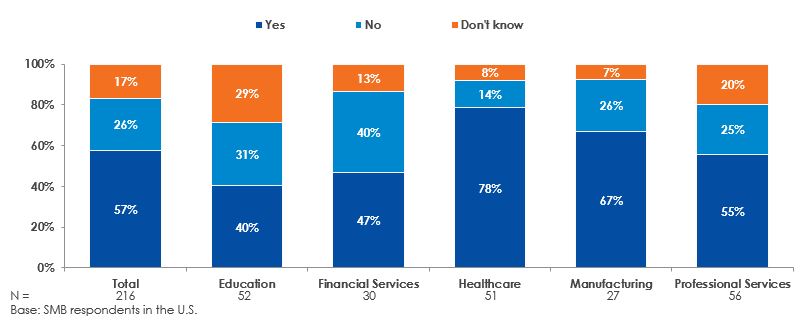Many companies are seeking to boost productivity through software tools, including document management solutions, that automate manual processes. According to Keypoint Intelligence-InfoTrends research, more than half of companies say they have automated at least some business processes in their organization—with sectors like healthcare (78%) and manufacturing (67%) taking the lead.

Source: Keypoint Intelligence-InfoTrends research
In terms of company size, organizations with 100 or more employees (64%) are most likely to have automated processes. That said, smaller companies (50%) are catching up.
How does document management software automate processes?
Traditionally, companies have stored many of their records in paper form for easy accessibility and portability. While this may still be the best approach for some organizations, others find the ever-growing amount of information they handle a challenge to organize and locate manually. Furthermore, hardcopy storage can be expensive—considering costs like paper, filing cabinets, and square footage (especially in a big city).
Document management software aims to improve the efficiency of information storage and access, with features like:
- Automated extraction and input of scanned information
- Automated creation of document metadata
- Powerful database search capabilities
- Pre-programmed automated workflows
- Pre-set access and approval configurations
- Automated version control
These are just a sample of the automated features that can be found in today’s document management systems. These capabilities replace time-consuming and repetitive manual tasks, enabling employees to spend more time on business priorities.
What are some other applications that automate document-related tasks?
In addition to document management, software exists for tasks like print/scan management and document capture. Print and scan management software tracks the use of print and scan on a multifunction printer (MFP), helping organizations derive insight into where efficiencies and security can be achieved. It can help organizations optimize their MFP-related processes, through methods like rules, restrictions, and user authentication.
Document capture software, meanwhile, helps organizations easily convert paper documents into digital files. Features may include customized indexing, file format conversion, barcode recognition, zonal optical character recognition (OCR), and blank page deletion. In some cases, this software may be required in addition to document management systems.